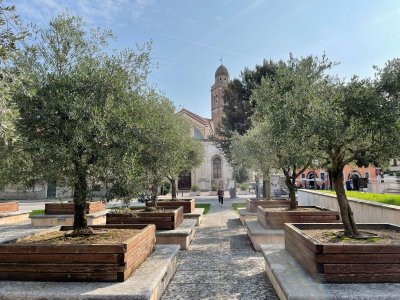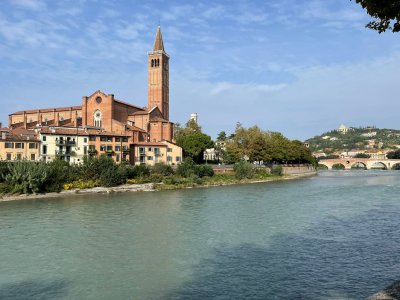The Conference Location
City of Verona
The city of Verona lies in northeastern Italy in the Veneto region. The old city lies within the embrace of the Adige River, with the new and old parts linked by bridges. Venice (Venezia) lies 120 km (75 miles, 1 hour by train) to the east. Milan (Milano) is 140km (87 miles, 1 hour by fast train) to the west. The old city centre is mainly a pedestrian area, so be prepared to walk around. Whilst doing so you may spot one or more of the large ammonite fossils embedded in the stone paving slabs, imprints of a different kind dating from prehistory!
Verona is famously the setting for two of the plays of William Shakespeare: Two Gentlemen of Verona and arguably his most famous play, Romeo and Juliet. It is highly unlikely however that Shakespeare ever visited the city.
For its historical and cultural significance, Verona was granted UNESCO World Heritage status in 2000
History
The city dates back to the Roman Period with buildings from this era still in use today. Most noticeable of these is the Arena (Arena di Verona), an amphitheatre, built for gladiatorial combat, dating from 30 BC, and the venue for the world-renowned Verona Opera Festival. Another working site, dating from this period is the Roman Theatre (Teatro Romano) which hosts open-air plays and concerts and is the site of an archaeological museum in the renaissance convent of St. Gerolamo, located alongside.
Tourism
If you are planning to spend some time in Verona before or after the conference, there are plenty of places to see and things to do, some have already been mentioned in the above sections. For more ideas, see the Visit Verona website. Other places in the vicinity you may consider visiting include Venice and Lake Garda, the Valpolicella region, which offers the possibility to taste and buy excellent regional wines; the cities of Milan and Bologna or the Dolomites for a glimpse of these unique mountains.
Food and Drink
Verona and its province rule the roost when it comes to wine: wine is a serious matter here and the result is excellence in taste and refinement. The viticultural area around Verona is among the most renown in the world with a long tradition and top products. Among the most famous wines are: Amarone, Valpolicella and Recioto from the Valpolicella, Custoza, Soave from the Soave hills, Lessini Durello and Lugana from area around Lake Garda.
Tasting local food enhances the experience of Verona. The Veneto region has a rich and tasty culinary tradition, made up of dishes that have been handed down for centuries, from one generation to another. So, what to eat when in Verona? Traditional dishes are:
- Amarone risotto: the Amarone is among the top red wines worldwide and it is produced in the northern Verona’s valley Valpolicella is matched to the Vialone Nano rice, which is cultivated south of Verona – and carries the PGI sign. The combination in the form of risotto enhances two excellences of the territory.
- Risotto from Vialone Nano rice is delicious when served with squash and local sausages; with radicchio (red chicory salad) and Monte Veronese cheese, or with peas, known locally as ‘risi e bisi’.
- Pasta e fagioli: pasta with beans is one of the most famous Venetian and Verona dishes all over the World. It's made with short-cut extruded pasta, beans, broth, onion, garlic, celery, lard and different spices. It is thick and tasty.
- Gnocchi: gnocchi, or potato dumplings are the star of Verona Carnival season. They can be served with many sauces. This is one to try!
- Tortellini: originally from Valeggio sul Mincio, known as the ‘lover's knot’ and produced using thinly rolled pasta which is tied and knotted like a handkerchief and filled with meat or one of the other more modern fillings.
- Boiled meat with pearà sauce: is the most ancient Veronese dish; boiled beef and vegetables are served with a special sauce (the pearà) made with breadcrumbs, pepper, cheese and broth.
- Pastissada de caval: a stew made with horse meat, red wine and onions; it comes with polenta (corn [maize] meal). Traditionally, it was a dish prepared for special occasions.
Money
The currency of Italy is the Euro (symbol: €) which is the common currency of 20 of the 27 member states of the European Union. Banknotes (bills) come in €5, €10, €20, €50 and €100. There are also €200 and €500 notes, but these are rarely used in day-to-day commerce. Smaller denominations are the €1 and €2 coins which are bimetallic in nature. The Euro is divided into 100 cents, with smaller value coins being 1c, 2c, 5c, 10c, 20c, 50c. An interesting fact is that, while the same banknotes are used throughout the Eurozone, each of the constituent countries issues their own coins. Look through your small change and you may find coins from any of these countries represented. Don't worry though, they are legal tender in all the Eurozone countries, including Italy!
Card payments are ususally accepted in shops, but carry some cash to pay small amounts. Visa and Mastercard are commonly accepted, American Express less commonly so. Contactless payment (limit €50), by card or phone, is common. Another possible option is to buy a pre-paid card in the Euro currency which avoids foreign currency transaction fees applied to every purchase.
Tipping in cafés and restaurants is not obligatory in Italy but shows appreciation for good service. A tip of €2 to €4 per person in a restaurant is sufficient. If buying a coffee, wine, or beer leaving the change, or €1-2 often covers the tip. Always tip in cash.
Weather
The average temperature in June is 21°C (70°F) with highs of 27°C (81°F) and lows of 16°C (61°F). Light clothing is therefore advised. There are approximately 11 days with rain during the average June, so you may want to pack an umbrella.
Thanks to our corporate donors and sponsors for supporting this event



















